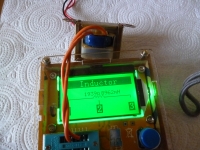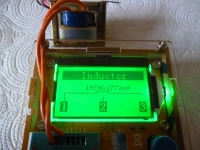DiZMar wrote:You are very critical of this tester - you probably have not received it from Gulsona screwdriver for protection.should display a message that the result is out of range as normal meters or other "simple" devices measuring even weight



Czy wolisz polską wersję strony elektroda?
Nie, dziękuję Przekieruj mnie tamDiZMar wrote:You are very critical of this tester - you probably have not received it from Gulsona screwdriver for protection.should display a message that the result is out of range as normal meters or other "simple" devices measuring even weight



Adamcyn wrote:I got a screwdriver, of course. This does not change my honest assessment. It is difficult to name regularity irregularity . Out of range this out of range not any random indication . A simple weight outside the range squeals or otherwise indicates that the range has been exceeded and not after the subsequent positions of the same mass each time different. A simple voltmeter, even a tilting device, bases a hint on the final limiter or even destroys it if the range is too high. A heavy truck with a heavy banner simply throws it. Give more examples?... You are very critical of this tester - you probably have not received it from Gulsona screwdriver for protection....
 Two ZX5.6 (5.6V 12.5W) generators and a regular rectifier.
Two ZX5.6 (5.6V 12.5W) generators and a regular rectifier.
pawelr98 wrote:It's a remake, combinations have any sense at all? I understand that to make them out of boredom, and only for that reason9V batteries do not use because the instruments are converted to external power supply.
bestler wrote:In universal meters, they often used up much faster. Battery voltage drops have deteriorated the precision of measuring diodes and small resistor resistors. I happen to do long measurements. Recently, for example, for about an hour I measured the base current of the transistor which worked at 90 ° C (KD502 at almost 60W power). To the extent that the sticks can be bought almost anywhere, the 9V batteries are different. To buy such a battery, sometimes I had to go to another store. And just like that I just plug in this power supply and I have peace. The meter from the picture has a 7.5V zener in it which lowers the voltage to the required level. As I mentioned earlier, the tester will be doing a long series of measurements. I have a lot of items to check out. Depending on what I disassemble, I can even reach several transistors after a few minutes. I have a lot of electronic scrap which serves me as a source of components. I have a small bucket full of coils, transformers or chokes.And the 9V battery lasts for a year and I do not know why you're combining.
E8600 wrote:Well, I do not like it too, but I would not like to change the power system when I think that the battery can last months or years. Sure, if I had to change the batteries at least once every 4-6 months, maybe I would think about it, but sooner than the battery, which is in the price of a good battery. Although I have recently listened to my colleagues in the forum and bought these batteries in Carefur, alkaline for 5pln with the hook. Anyway, in stores I look, electronic online are and after 4, x pln, also alkaline. So when shopping you can think about adding to the order. Let it lie. The change in power is the idea how it will become really difficult to access.I see that not only I do not like 6F22 (9V).
bestler wrote:You can buy interesting rechargeable batteries from Chinese. In a typical 6F22 casing, we have a lipo accumulator, a 9V converter and a charging system. Charging via microUSB. They also make such batteries in the AA and AAA variant. I would buy it myself, but 9V costs 25-30 PLN / piece. The capacity is also so-so because 400mAH (moreover, somewhat overstated by those who started and tested the link). One of the things I want to see is how it will react on TL431 with the REF pin shorted to the cathode. In this configuration it behaves like a 2.5V zener diode.But ... I have a clamp meter from Sonel, which I use once in a few weeks (measurements rather short, up to several minutes max) and the battery often sits up that personally annoys me - but I can not do anything about it except to bring a stock with me. I also had a gauge some cheap, I do not remember the brand and the battery also fell down every now and then, I've got rid of it.
pawelr98 wrote:Dear friend, as long as you are the lucky owner of this tester, it's simpler than to connect this TL_a.One of the things I want to see is how it will react on TL431 with the REF pin shorted to the cathode. In this configuration it behaves like a 2.5V zener diode.
E8600 wrote:Either that's another solution or this presenter has done something. For me (the first three from left), both the upper and lower contacts are 1-2-3.I have spied this solution here.
Adamcyn wrote:I did not calibrate the tester.And what about the calibration?
Quote:After unpacking the new tester, a calibration should be performed, we do this by connecting 1-2-3 leads with the minimum resistance (eg with two jumpers from a silver or unnecessary resistor terminals). We press the microsite and the calibration starts, 38% will be asked to remove the jumpers, to connect 82% to the leads 1-3 previously prepared capacitor with a capacity greater than 100nF.
vodiczka wrote:Here: https://www.elektroda.pl/rtvforum/topic3354445.html "After unpacking the new tester, it is necessary to carry out the calibration, we do it by connecting 1-2-3 outputs with the minimum resistance (eg with two jumpers from silver or unnecessary terminals of resistors) We press the microsite and the calibration starts, 38% will be asked to remove the jumpers, to connect 82% to the leads 1-3 previously prepared capacitor with a capacity greater than 100nF. "I did not calibrate the tester.What is the calibration?
vodiczka wrote:On disconnected power supply, pins 123 close, turn on the power and press the button. Then follow the instructions on the screen. Anyway, the description is on YT in some tutorial. I do not know (I did not calibrate either - I checked that it was measuring correctly, so I decided it was unnecessary) if this model calibrates too. A friend of mine last ...What is the calibration?
vodiczka wrote:This tester has a slightly different tile shape than the gadget, so it can have different leads.Either that's another solution or this presenter has done something. For me (the first three from left), both the upper and lower contacts are 1-2-3.
398216 Usunięty wrote:In the film from # 322 in 12:10 the author measures double-coil (in 3 Dvodiczka wrote: what is the calibration? On disconnected power supply, pins 123 close, turn on the power and press the button.
